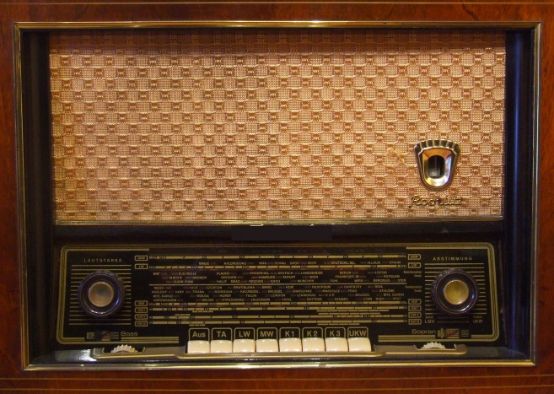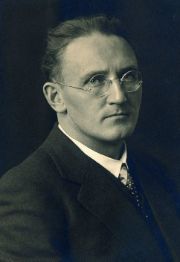Radio as an educational mission
Hermann Scherchen, musical director of Radio Beromünster from 1945-50, saw the radio as a means of musical education. In his "Hörtheater", he reworked classical-romantic stage music into broadcasts with words and music.

Hermann Scherchen (1891-1966) expected a great deal from the development of radio for a democratic musical education of the people. He was involved right from the start: his first radio concert for Schönberg's 50th birthday in 1924, musical director of the Königsberg "Ostmarkenrundfunk" in 1928, musical advisor to the Reichsrundfunk-Gesellschaft in Berlin in 1932. From 1945 to 1950 he was head of music at Radio Beromünster and conducted the Zurich studio orchestra. In 1950, his study Music for everyone - dedicated to the unknown radio listener.
In a "Confession to Radio", he sees the new medium as "the most significant upheaval in the life of nations since the invention of printing". Like others in the early days of the medium, he also hoped that radio would mobilize listeners to become active themselves - both artistically (musically) and intellectually (politically). In 1930, at the Baden-Baden Music Festival, he conducted the world premiere of Brecht's Lindbergh flight, a "radio teaching piece". The audience should be involved.
In an essay Broadcasting in its relationship to music cultivation and music education Scherchen reflected in 1930 on the "music-interpreting, meaning-creating word"; it was available in the form of "the poeticizing presentation of a musical work", but also "as a work analysis strictly limited to the musical processes". He does not believe in extensive introductory lectures; instead, he prefers the "musical announcement" - "from the briefly headlined report to the anecdotal recording of a contemporary milieu, or a sensitive message that leads directly into the emotional sphere".
-

Hermann Scherchen, photo: Myriam Scherchen family archive / wikimedia commons
Around 1930, Scherchen considered radio plays with music as a "form peculiar to radio" and Stravinsky's L'histoire du soldat, Hermann Reutters Saul and Milhaud's Le bœuf sur le toit realized in this way. In the 1940s, he envisioned "novel but immediately comprehensible combinations of music and words", like Dostoyevsky's Grand Inquisitor with music by Tchaikovsky. He also turns to classical-romantic stage music in arrangements as an "audio theater": Egmont, A Midsummer Night's Dream, L'Arlesienne, Peer Gynt. In addition, a poetic interpretation of the Prometheus-Beethoven's ballet and Schumann's "dramatic poem" Manfred after Byron, compressed. By limiting each episode to three quarters of an hour, he has a cyclical broadcasting slot in mind.
Recordings of the "Hörtheater" already on Radio Beromünster; but the series was recorded in its entirety at Leipzig Radio from November 25 to December 1, 1960. Scherchen, who had been closely associated with Leipzig since the 1920s and was also twice appointed Gewandhaus conductor after the end of the war, was twice guest conductor of the Radio Symphony Orchestra in the Gustav Mahler year 1960. This brought his radio arrangements to the fore and the recording date was arranged at short notice. An unparalleled tour de force: orchestral rehearsals in the morning, rehearsals with the soloists and choir in the afternoon and recordings in the evening from eight o'clock to eleven or even until midnight. According to Myriam Scherchen, he was so enthusiastic about the result that he considered a record edition - but this never materialized. His daughter has fulfilled his legacy: an exemplary edition, including all of Scherchen's texts, in a three-part CD cassette Musique et litterature on the "Tahra" label installed by her (TAH 103-105).
Scherchen's intention with his "Hörtheater" was to draw attention to music for stage plays which, as a result of changes in theatrical practice, is hardly ever heard any more, at least not in connection with poetry. He also pursued music education interests: Musical understanding should be created through the interplay of words and sound. As he explains to the Leipzig music editor Klaus Richter: ways and means must be found "to turn listeners who are not yet interested into interested listeners in the most diverse ways". Forms of broadcasting should be sought "that put listeners in a state of psychological tension, that allow them to approach the music with openness and excitement, that place them in an educational frame of reference in which they can place the music they are listening to."
Due to the limitation to three quarters of an hour in each case, interventions in the scores - cuts - are necessary. But Scherchen takes liberties in general, even reassigning musical numbers. He either lets the commentary speak in the pauses - even self-deprecatingly placed in the music! -or he overlays the notes with words in the manner of melodrama. Some of it is reminiscent, in a good or bad sense, of the methods of film music. Scherchen may have meant this when he refers to the "aesthetic contestability" - but accepts it for the sake of the pedagogical intention.
Myriam Scherchen calls her father's arrangements a "truly new creation". The selection is to be understood as quasi autobiographical. The focus is on the "almost Faustian struggle of man with his desires" and redemption through love. Her father led the life of a man "who wanted to know everything, an autodidact who believed in man and his omnipotence, but who needed love to give his own overarching activity a spiritual meaning".
Six times "Hörtheater"
Beethoven's ballet The Creatures of Prometheus or The Power of Music and Dance fell into oblivion after its premiere in Vienna's Burgtheater in 1801. Only the overture has survived in the concert repertoire. The ballet tells the story of the ennoblement of man through the art of music.
Scherchen takes a different approach and focuses on the theft of fire by Prometheus and his punishment with Pandora's box, from which the evils of this world escape - a thorough conversion! In the ballet, the muses demonstrate refinement through art to the sound of the harp - Scherchen assigns the Piece to Pandora, who captivates with beauty but brings disaster with her. And a dance of arms by the Bacchantes becomes a sign that the box is open and evil is coming out. The score has been drastically shortened: only seven of Beethoven's sixteen musical numbers and the overture have been preserved.
Goethe writes in his Egmont Beethoven repeatedly composed music for the stage and delegated it to composers from his circle. Beethoven's score was written without his knowledge in 1809/10 as a commission from the Viennese court theater. In addition to the prescribed settings - two songs by Klärchen, music describing her "death" and the dream vision of Egmont - he added inter-act music.
A version for the concert hall "with declamatory accompaniment" was created during Beethoven's lifetime. Scherchen went his own, unconventional way. He follows the course of the plot with his commentary, preserves all the music but rearranges some of it. Klärchens Lied The drum stirredaddressed to the mother in the play, here as an invitation to Egmont's people! Scherchen's music for Klärchen's death indicates Egmont's "last anxious night". Nor is Klärchen, as in Goethe, mixed into the allegory of "freedom" at the end - the political should remain separate from the private. In general, the love story is pushed back - everything is concentrated on the protagonist and his steadfastness.
Mendelssohn's music to Shakespeare's A Midsummer Night's Dreamcomposed on the initiative of the Prussian king and premiered in 1843 at the Neues Palais in Potsdam, comprises thirteen tracks in addition to the overture (composed as early as 1826) - a quarter of the length of the play!
From a Romantic perspective, Mendelssohn concentrates on the fairy world, and Scherchen limits himself entirely to this in his "Hörtheater". It would have been far too complicated to describe the plot in detail. Just a few words: Scherchen's aim is to let the music "speak".
For the premiere of Alphonse Daudet's L'Arlesienne 1872 at the Théâtre lyrique in Paris, the dramatization of a novella from the Letters from my millGeorges Bizet composed twenty-seven musical numbers. The piece failed - which also meant the end for this score.
But the music lives on in the two orchestral suites compiled from it: the first by Bizet's hand, the second arranged posthumously by his friend Ernest Giraud. Scherchen leaves the stage play aside and sticks to a narrative based literally on the novella. He also takes the orchestral suites as his starting point, freely arranging their movements, even in abridged form. The words superimposed on them create a continuous melodrama.
For the adaptation of Henrik Ibsen's "dramatic poem" Peer Gynt Edvard Grieg composed twenty-three musical numbers as a play in 1876 - instrumental pieces, songs, choruses and melodramas. However, he was not at all satisfied with the performance. He continued to tinker with the score and struggled to produce a definitive version. The incidental music was only published posthumously in 1908.
The two orchestral suites from it had long since begun their triumphal march through the concert halls. As with L'ArlesienneScherchen sticks exclusively to this in his "Hörtheater" and leaves the incidental music to one side. He lets Peer Gynt narrate the plot - here limited to just a few stages - as a memory of his life. The eight movements of the suites are hooked into the events. The Morning mood, the introduction to the African act in the play, is moved to the beginning and refers to Norway. A good decision, because the folkloristic intonations don't really fit the exotic setting at all.
When Robert Schumann wrote Byron's Manfred he retained the term "dramatic poem" but, contrary to Byron's own ideas, who aimed for a "theater of thought", he wanted the stage for it. Liszt conducted the premiere at the Weimar court theater in 1852.
Schumann himself once spoke of the "foil character" of his music - apart from the brilliant overture, his contributions are rather modest. Byron's original is cut by about a quarter and the title character is left as a speaking part. Some of the words are inserted into the pauses, others are subject to the music. It is declaimed freely - only partially rhythmically fixed. Singing - with the exception of the Requiem at the end - is assigned to the "spirit realm".
The cue "Gedankentheater" given by Byron must have particularly appealed to Scherchen for his purposes. He preserves the musical sequence, but shortens the text further and also uses a new translation - with differences to Schumann's declamatory formulas! He even intervenes twice in the instrumentation. For the "Song of the Spirits of Ariman", bare percussion formulas are used instead of the tutti orchestra. The religious theme is pushed back - not an offering of grace from the church! At the end, the Requiem is performed a cappella without "incense" from the organ accompaniment.
Myriam Scherchen sees the concept of the "Hörtheater" as reflecting various characteristics of Scherchen as a "human being". He expresses his world view in it - even through careful interventions. This includes his "didactic will": "His aim was to pass on to his fellow human beings as far as possible the encounter with music that had helped him to achieve freedom of action, spirit and ideas." The title of his Winterthur book expresses this in a nutshell: Music for everyone!
The three-part CD cassette "Musique et litterature" with the six "Hörtheater" programs was released on the Tahra label (TAH 103-105). However, it is out of print.







